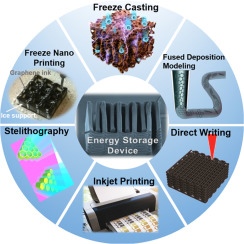当前位置:
X-MOL 学术
›
Nano Energy
›
论文详情
Our official English website, www.x-mol.net, welcomes your feedback! (Note: you will need to create a separate account there.)
3D Printing Technologies for Electrochemical Energy Storage
Nano Energy ( IF 17.6 ) Pub Date : 2017-08-24 , DOI: 10.1016/j.nanoen.2017.08.037 Feng Zhang , Min Wei , Vilayanur V. Viswanathan , Benjamin Swart , Yuyan Shao , Gang Wu , Chi Zhou
Nano Energy ( IF 17.6 ) Pub Date : 2017-08-24 , DOI: 10.1016/j.nanoen.2017.08.037 Feng Zhang , Min Wei , Vilayanur V. Viswanathan , Benjamin Swart , Yuyan Shao , Gang Wu , Chi Zhou

|
Fabrication and assembly of electrodes and electrolytes play an important role in promoting the performance of electrochemical energy storage (EES) devices such as batteries and supercapacitors. Traditional fabrication techniques have limited capability in controlling the geometry and architecture of the electrode and solid-state electrolytes, which would otherwise compromise the performance. 3D printing, a disruptive manufacturing technology, has emerged as an innovative approach to fabricating EES devices from nanoscale to macroscale, providing great opportunities to accurately control device geometry (e.g., dimension, porosity, and morphology) and structure with enhanced specific energy and power densities. Moreover, the “additive” manufacturing nature of 3D printing provides excellent controllability of the electrode thickness with much simplified process in a cost effective manner. With the unique spatial and temporal material manipulation capability, 3D printing can integrate multiple nano-materials in the same print, and multi-functional EES devices (including functional gradient devices) can be fabricated. Herein, we review recent advances in 3D printing of EES devices. We focus on two major 3D printing technologies including direct writing and inkjet printing. The direct material deposition characteristics of these two processes enable them to print on a variety of flat substrates, even a conformal one, well suiting them to applications such as wearable devices and on-chip integrations. Other potential 3D printing techniques such as freeze nano-printing, stereolithography, fused deposition modeling, binder jetting, laminated object manufacturing, and metal 3D printing are also introduced. The advantages and limitations of each 3D printing technology are extensively discussed. More importantly, we provide a perspective on how to integrate the emerging 3D printing with existing technologies to create structures over multiple length scale from nano to macro for EES applications.
中文翻译:

电化学储能的3D打印技术
电极和电解质的制造和组装在促进电化学能量存储(EES)设备(例如电池和超级电容器)的性能方面起着重要作用。传统的制造技术在控制电极和固态电解质的几何形状和结构方面的能力有限,否则会损害性能。3D打印,一种破坏性的制造技术,已经成为一种创新的方法,可以将EES设备从纳米级制造到宏观级,为准确控制设备的几何形状提供了巨大的机会(例如,尺寸,孔隙率和形态)和具有更高比能量和功率密度的结构。此外,3D打印的“累加”制造性质以极具成本效益的方式,以大大简化的工艺提供了极好的电极厚度可控性。凭借独特的时空材料处理能力,3D打印可以在同一张打印中集成多种纳米材料,并且可以制造出多功能EES设备(包括功能性梯度设备)。本文中,我们回顾了EES设备3D打印的最新进展。我们专注于两种主要的3D打印技术,包括直接书写和喷墨打印。这两种工艺的直接材料沉积特性使它们能够在各种平坦的基底上印刷,甚至是保形的基底,非常适合于可穿戴设备和片上集成等应用。还介绍了其他潜在的3D打印技术,例如冷冻纳米打印,立体光刻,熔融沉积建模,粘合剂喷射,层压物体制造和金属3D打印。每种3D打印技术的优点和局限性都得到了广泛讨论。更重要的是,我们为如何将新兴的3D打印与现有技术进行集成提供了一个视角,从而为EES应用创建了从纳米到宏观的多长度尺度的结构。每种3D打印技术的优点和局限性都得到了广泛讨论。更重要的是,我们为如何将新兴的3D打印与现有技术进行集成提供了一个视角,从而为EES应用创建了从纳米到宏观的多长度尺度的结构。每种3D打印技术的优点和局限性都得到了广泛讨论。更重要的是,我们为如何将新兴的3D打印与现有技术进行集成提供了一个视角,从而为EES应用创建了从纳米到宏观的多长度尺度的结构。
更新日期:2017-08-24
中文翻译:

电化学储能的3D打印技术
电极和电解质的制造和组装在促进电化学能量存储(EES)设备(例如电池和超级电容器)的性能方面起着重要作用。传统的制造技术在控制电极和固态电解质的几何形状和结构方面的能力有限,否则会损害性能。3D打印,一种破坏性的制造技术,已经成为一种创新的方法,可以将EES设备从纳米级制造到宏观级,为准确控制设备的几何形状提供了巨大的机会(例如,尺寸,孔隙率和形态)和具有更高比能量和功率密度的结构。此外,3D打印的“累加”制造性质以极具成本效益的方式,以大大简化的工艺提供了极好的电极厚度可控性。凭借独特的时空材料处理能力,3D打印可以在同一张打印中集成多种纳米材料,并且可以制造出多功能EES设备(包括功能性梯度设备)。本文中,我们回顾了EES设备3D打印的最新进展。我们专注于两种主要的3D打印技术,包括直接书写和喷墨打印。这两种工艺的直接材料沉积特性使它们能够在各种平坦的基底上印刷,甚至是保形的基底,非常适合于可穿戴设备和片上集成等应用。还介绍了其他潜在的3D打印技术,例如冷冻纳米打印,立体光刻,熔融沉积建模,粘合剂喷射,层压物体制造和金属3D打印。每种3D打印技术的优点和局限性都得到了广泛讨论。更重要的是,我们为如何将新兴的3D打印与现有技术进行集成提供了一个视角,从而为EES应用创建了从纳米到宏观的多长度尺度的结构。每种3D打印技术的优点和局限性都得到了广泛讨论。更重要的是,我们为如何将新兴的3D打印与现有技术进行集成提供了一个视角,从而为EES应用创建了从纳米到宏观的多长度尺度的结构。每种3D打印技术的优点和局限性都得到了广泛讨论。更重要的是,我们为如何将新兴的3D打印与现有技术进行集成提供了一个视角,从而为EES应用创建了从纳米到宏观的多长度尺度的结构。


























 京公网安备 11010802027423号
京公网安备 11010802027423号